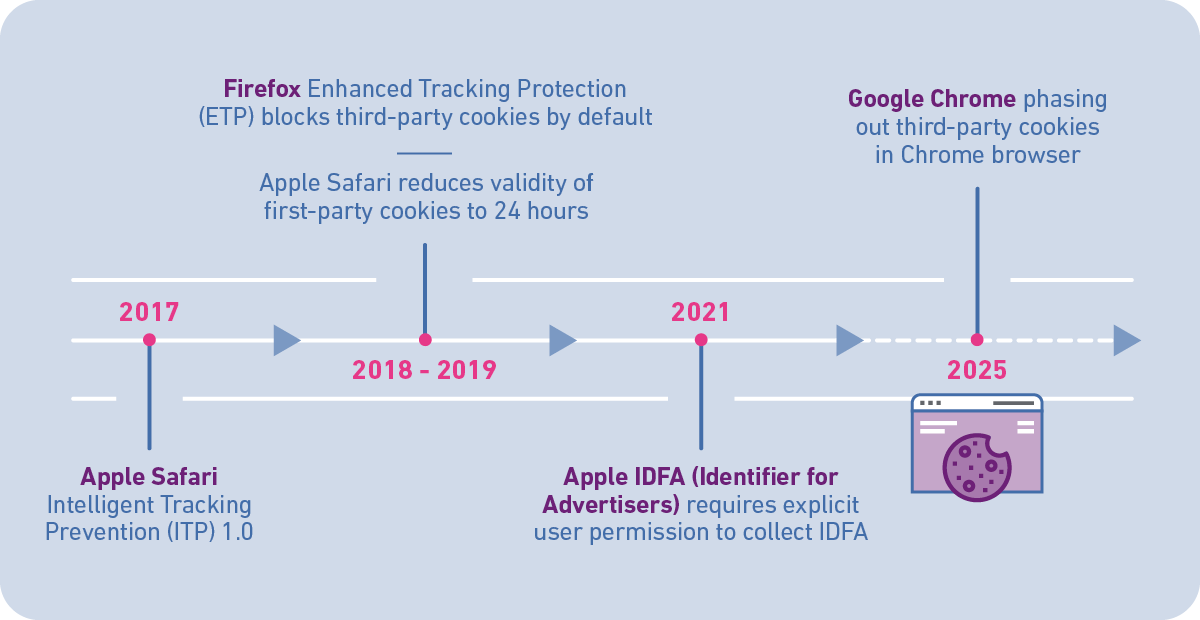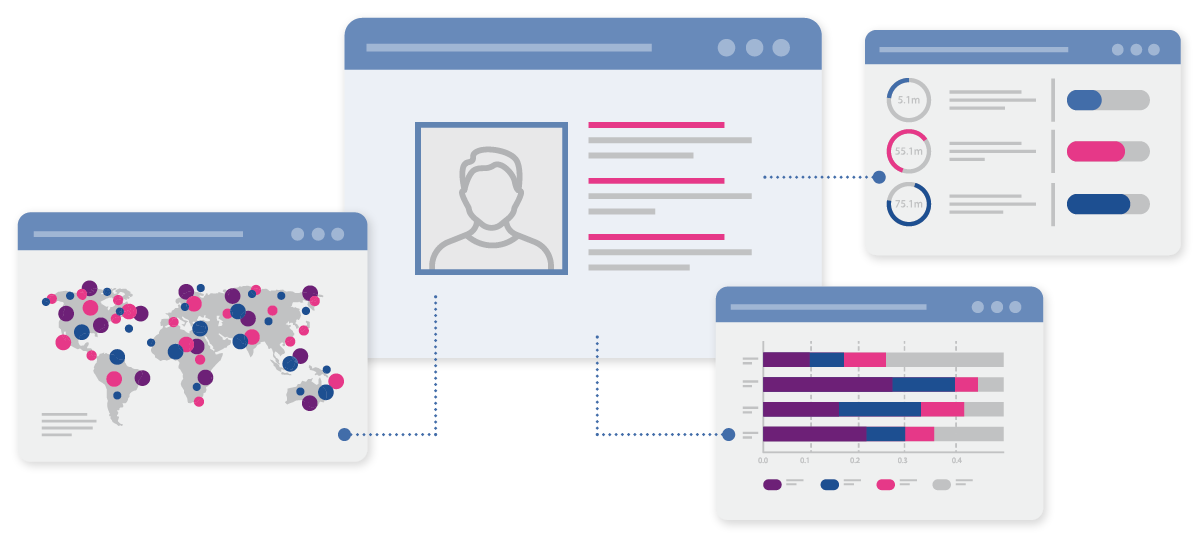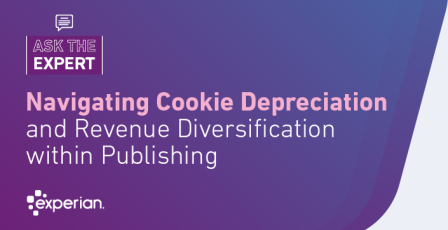Since we published this guidance, Google announced on 22 July 2024 that it will not fully phase out third-party cookies. The guidance in this post, however, remains relevant.
While Google’s third-party cookies remain in use, users can opt out, meaning advertisers will continue to face limitations. As a result, it’s important for marketers to reduce reliance on cookies by diversifying their data strategies. For more on these recent changes, see our article on Google’s cookie developments.
The deprecation of third-party cookies signals a monumental shift in online advertising, forcing businesses to pivot towards a cookieless future.
Staying ahead requires adapting to new tracking technologies, laying the groundwork for effective engagement in the evolving digital landscape. Get to know the challenges of a cookieless future and how brands and publishers can effectively move forward in this new data landscape.
Yes, third-party cookies are coming to an end
Last month, and for the third time, Google has pushed back the timeline for phasing out third-party cookies in the Chrome browser. Google now plans to eliminate third-party cookies in 2025. Despite the postpone of this change, experts believe that Google is still committed to phasing out third-party cookies. This change will mark the final transition into the new cookieless future.
This final change has sparked widespread concern among brands, businesses, and advertising agencies who have long relied on third-party cookies for targeted advertising and personalised marketing campaigns.
With Google, the internet’s most popular browser at over 60% of the market share[1], following in the footsteps of Apple and Firefox, businesses are grappling with how to effectively reach and engage audiences without relying on traditional tracking methods. Whilst Google is yet to phase out third-party cookies, adaptation to new technology remains a priority for many businesses now.

Why are third-party cookies being phased out?
Third-party cookies are being phased out primarily due to growing concerns about privacy and data tracking. Third-party cookies allow advertisers and other third-party entities to track users across different websites, creating detailed profiles of their online behaviour and preferences. However, this practice raises privacy issues, as users may feel their online activities are being monitored without their consent. As a result, major web browsers and tech companies are responding to these concerns by phasing out support for third-party cookies.
Apple’s App Tracking Transparency (ATT) framework, introduced in iOS 14.5, now requires users to say “yes” before their data can be tracked across different apps or websites. Initiatives like the Global Privacy Control (GPC) also let users signal their preferences for data sharing. In addition, regulations like Europe’s General Data Protection Regulation (GDPR) and California’s Consumer Privacy Act (CCPA) have set strict rules for how companies handle personal data, focusing on transparency and user consent.
Google recently made a big move towards phasing out third-party cookies. On January 4, 2024, they announced a new “Tracking Protection” feature that automatically limits cross-site tracking. This is being rolled out gradually during 2025, starting with 1% of random Chrome users worldwide, about 30 million people.
Overall, the move to phase out third-party cookies reflects a broader industry trend toward more privacy-conscious approaches to online tracking and advertising.
The challenges of a cookieless world
To mitigate the impact of this cookieless future, we need to understand what challenges brands, publishers and consumers might face. Challenges include:
Loss of audience targeting
One of the main concerns revolves around audience targeting. The absence of cross-website user tracking presents substantial obstacles for traditional retargeting and prospecting methods.
Previously, cookies held valuable data for businesses regarding users’ browsing destinations. This data enabled advertisers to tailor their strategies effectively. But in a cookieless environment, this visibility diminishes, making it increasingly difficult to reach desired audiences.
Difficulty in measuring ad performance
Measuring ad performance becomes challenging without third-party cookies. Advertisers depend on cookies to track various user activities beyond simple ‘see an ad, then buy’ scenarios, including referral sources and cross-channel interactions. The lack of detailed data complicates evaluating campaign effectiveness and obscures the complete picture of user journeys, leaving marketers with an inadequate understanding of audience engagement and conversions.
Reduced ad personalisation
The decline of third-party cookies threatens to diminish the efficacy of targeted advertising and personalised content delivery. Advertisers face challenges in reaching specific audiences with tailored messaging in a world of cookieless ads.
Disjointed user experience
Cookies are used to personalise the online experience by remembering user preferences, login details, and shopping carts across websites. Without cookies, consumers may lose these personalised experiences, leading to a more generic browsing experience.
Increased reliance on first-party data collection
Without third-party cookies, first-party data collection has become more significant than ever. A shift that comes with its own set of challenges. Marketers must navigate the complexities of sourcing and utilising first-party data effectively, balancing the need for audience insights with users’ privacy concerns.
There are concerns around the scalability of first-party data for a few reasons:
- Limited reach: First-party data is confined to a business’s existing customers or site visitors, limiting the ability to reach new potential customers.
- Data variety: The types of data collected are often restricted to specific interactions or transactions, lacking the diversity found in third-party data pools.
- Resource intensive: Collecting, managing, and analysing first-party data requires significant resources and technology, which may be challenging for smaller businesses.
- Privacy concerns: Increasing regulations and consumer sensitivity around data privacy can restrict how much data can be collected and how it can be used.
- Quality and relevance: Maintaining the relevance and quality of first-party data over time can be difficult as consumer behaviour and interests change.
Insufficient resources to invest in alternative solutions
A key challenge that businesses will face is the shortage of resources to allocate towards alternative solutions. Businesses may lack the financial means and technical proficiency to investigate and implement new technologies. Apprehension regarding adaptation to new technology may impede their ability to stay competitive and increase the risk of falling behind their competition.
What are the impacts of a cookieless future?
The digital landscape is undergoing a significant transformation that affects everyone online. Let’s take a look at how this shift impacts different groups:
For brands and agencies
The absence of third-party cookies poses a challenge for brands and agencies. Without the ability to track user behaviour across the web, targeting and measuring the effectiveness of ad campaigns become more complicated. This uncertainty can make it difficult to gauge the true bottom-line impact on your business and hinder efforts to reach your target audience effectively.
For publishers
Publishers face their own unique challenges in a cookieless environment. Publishers rely on targeted advertising for a significant portion of their revenue. Without third-party cookies, advertisers may find it harder to target specific audiences, leading to potentially lower ad revenues for publishers. This could particularly affect publishers with niche audiences who rely heavily on targeted advertising.
In an environment where targeted cookieless advertising becomes more challenging, publishers may place a greater emphasis on creating high-quality content and improving user experience to attract and retain audiences. Providing valuable content and a seamless browsing experience can help publishers maintain and grow their audiences despite changes in advertising practices. This additionally benefits both users, who receive tailored content, and brands, which enjoy higher-quality interactions and a better reputation.
For end-users and consumers
Consumers will notice changes in their online experience as we move towards a cookieless future. Personalisation may reduce, at least in the short term, with fewer relevant ads. While this enhances privacy, users may become frustrated by a less tailored and more unpredictable digital space.
The decrease in ad revenue that publishers are experiencing as a result of this phase out may also have a domino effect for users. Publishers are introducing new ways to make money online, most notably paywalls, meaning users are facing real time costs in order to access online content.
Adapting to the change: cookie deprecation doesn’t mean the loss of addressability
The upcoming deprecation of third-party cookies might seem like a huge hurdle. However, it’s important to recognise that this shift doesn’t spell the end of targeted advertising. Even without third-party cookies, practical solutions are available to uphold effective targeting and advertising strategies. Such as:
First-party data: This information directly collected from users offers valuable insights into consumer behaviour and preferences. However, it’s more difficult to aggregate, and reach may be narrower compared to third-party data. For this reason, it can’t be the only solution for brands, advertisers and publishers.
Alternative identifiers and ID graphs: Alternative identifiers and ID graphs offer a privacy-conscious alternative to third-party cookies, ensuring user privacy while maintaining cross-platform compatibility. Creating an identity graph requires significant expertise and financial investment.
Data clean rooms: Data clean rooms are secure environments that facilitate data collaboration among multiple parties without compromising individual privacy. In a data clean room, sensitive data is accessed, analysed, and processed in a controlled manner, preventing unauthorised access or exposure. These rooms are carefully structured to maintain compliance with privacy regulations and prevent data breaches. Implementing and maintaining a data clean room can be complex due to the stringent security measures required, but they offer a promising solution for enabling data collaboration while safeguarding individual privacy.
Contextual advertising: Contextual advertising is a type of online advertising that targets users based on the content of the websites they are currently visiting. Instead of relying on the user’s browsing history or previous behaviour, contextual advertising algorithms analyse the keywords, themes, and context of the web page being viewed to display relevant ads. The challenge with contextual advertising is that the user may not be the advertisers’ intended audience.
Cohort-based targeting: By grouping users with similar interests and behaviours, cohort-based targeting offers a privacy-conscious alternative to individual tracking. However, it may lack the granularity of personalised advertising.
Google’s Privacy Sandbox: Google’s Privacy Sandbox initiative aims to develop privacy-friendly alternatives to third-party cookies to maintain effective advertising strategies, such as the Federated Learning of Cohorts (FLoC), which group users based on similar interests rather than tracking individual behaviour. However, critics are concerned about data monopolisation by tech giants like Google and the broader implications for businesses’ digital advertising and user tracking practices.
The looming deprecation of third-party cookies may appear daunting. Yet, this transition doesn’t signify the demise of targeted advertising. Even in the absence of third-party cookies, viable solutions exist to maintain robust targeting and advertising strategies.
Debbie Oates, Director of Customer Engagement, Experian Marketing Services
While these alternatives hold promise, each comes with its limitations. However, innovative solutions like our Consumer Sync solution offer ways to mitigate these shortcomings. By synchronising first-party and third-party data across platforms and devices in a privacy-conscious manner, Consumer Sync enables advertisers to maintain addressability without compromising user privacy.

With coverage of over 55% of UK households and over 120m digital identifiers, Consumer Sync offers the scalability necessary for brands, agencies, and publishers to engage previously untapped audiences and enhance campaign effectiveness. This is uniquely overlaid and verified against ConsumerView, our proprietary demographic file of over 95% of UK population, to ensure accuracy and the ability to enhance customer data with rich demographic insights.
- Wide-reaching scale
- Cookieless by design
- Privacy focused
- Enabling audience extension
- High levels of deterministic and probabilistic matching
- Unlocking audience insight
The deprecation of third-party cookies presents challenges and opportunities for innovation in digital advertising. By exploring alternative strategies and using advanced technologies, businesses can navigate this transition while prioritising user privacy and maintaining effective targeting capabilities.
Stay ahead of the curve with Consumer Sync
Looking for a way to navigate the cookieless future with ease? As third-party cookies fade into obsolescence, stay ahead of the curve by seamlessly connecting and enriching IDs across diverse signals, channels, and devices with our Consumer Sync solution.
Chat with an expert to find out more.
Related products
[1] Understanding Browser Market Share: Which browsers to test on in 2023, BrowserStack












